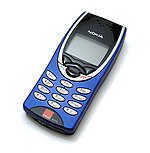
The Nokia 3510 is a mobile phone for the GSM network, introduced by Nokia on 12 March 2002. The phone was the first Nokia phone to bring GPRS internet services to the mass market. It was also the first Nokia phone to ship with Beatnik's miniBAE engine, allowing for playback of polyphonic ringtones.

The Nokia 3310 is a discontinued GSM mobile phone announced on 1 September 2000, and released in the fourth quarter of the year, replacing the popular Nokia 3210. It sold very well, being one of the most successful phones, with 126 million units sold worldwide, and being one of Nokia's most iconic devices. The phone is still widely acclaimed and has gained a cult status due to its reputation for durability.
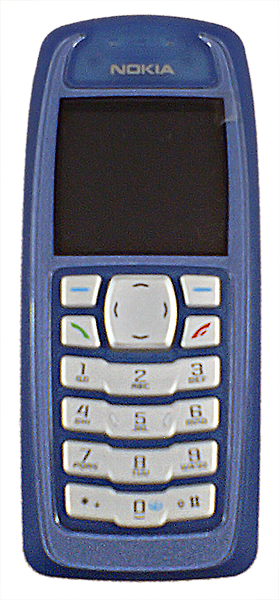
The Nokia 3100 is a triband-GSM mobile phone announced on 17 June 2003 as an entry-level phone from Nokia and released in September 2003, designed primarily for the newer generation of marketing audience.
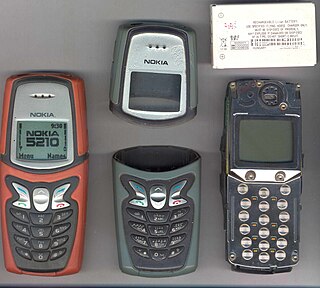
The Nokia 5210 is a mobile phone manufactured by Nokia. Announced on 19 November 2001, it was released in early 2002. The 5210 is designed for use in tough conditions and is dust, shock and water resistant. It features rubber Xpress-on shells, WAP over CSD and a built-in thermometer. The thermometer displays the internal temperature of the phone's battery. This feature is also present on other phones that have "netmonitor" enabled.

The Nokia 3210 is a GSM cellular phone, announced by Nokia on 18 March 1999.
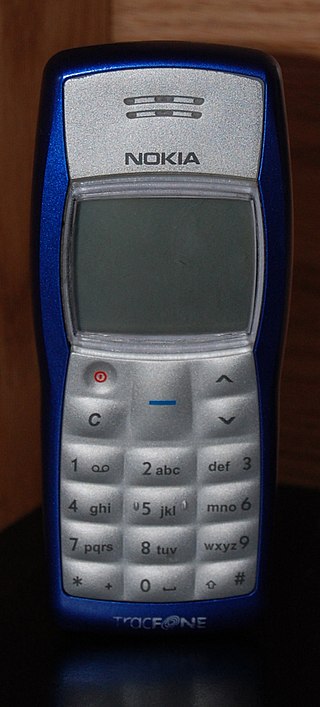
The Nokia 1100 is a basic GSM mobile phone produced by Nokia. Over 250 million 1100s have been sold since its launch in late 2003, making it the world's best selling phone handset and the best selling consumer electronics device in the world at the time. The model was announced on 27 August 2003 and was discontinued in September 2009.

The Nokia 3200 is a mobile phone by Nokia, part of the Nokia Expression (youth) series and announced on 12 September 2003. It is based on the Nokia Series 40 platform. The phone is an update of the Nokia 3100, while adding features from the Nokia 7250i and 6610i. The phone's feature set was very similar to the 7250i and 6610i, but featured different software and firmware installed, and was sold at a lower price than the 7250i or 6610i. Of the three phones, the 3200 was mainly targeted towards the youth market, the 7250i towards fashion-conscious users, and the 6610i towards business users. Core features include an XHTML browser, alarm clock, flashlight, EDGE and FM stereo radio with a 128 × 128 12-bit (4096) color screen. The phone has multimedia features such as picture and text messaging. Features carried over from the Nokia 3100 include ringer profiles and voice memo capability. It also has Java games. The phone has an extensive calendar with a lunar calendar. The flashlight is located under the phone and can be activated by holding the "star" (asterisk) key. The camera is on the back of the phone. The 3200 can also play both polyphonic and monophonic ringtones. The phone's visual interface in its menu system is similar to that of the Nokia 3100, using large, static icons rather than animated ones.
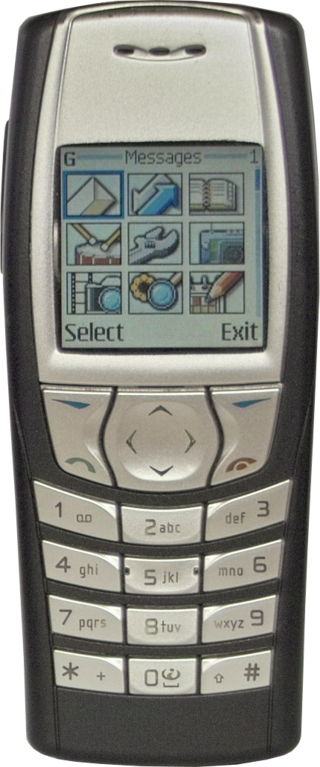
The Nokia 6610 is a handset by Nokia that uses the Series 40 platform and J2ME (Java). The device features text and picture messaging, a WAP browser, Stereo FM radio, Polyphonic ringtones and a 128x128, 4096-colour display. It is essentially the same phone feature-wise as the Nokia 7210, the 6610 being a more business-oriented version with a more conservatively-styled face plate and keypad layout, in contrast with the fashion-oriented 7210. It was introduced at CommunicAsia in June 2002 and was released in Q3 of the year.
The Siemens S40 is a mobile phone. Originally developed as the Bosch 1886 in 2000, the phone was branded as the Siemens S40 after Siemens acquired the Bosch mobile phone division. The Siemens S40 is a tri-band mobile phone that operates on the GSM-900, GSM-1800, and GSM-1900 networks. Communication with a computer can be done either through the infrared port (IrDA) on the phone or a USB or serial port data cable. Its more distinctive features include the voice memo recorder, the mute feature for conversations, the ability to record phone conversations, and the ringtone composer.

The Motorola StarTAC, first released on January 3, 1996, is often assumed to be the first ever clamshell (flip) mobile phone. Technically, however, NEC had been releasing flip phones on NTT Docomo's PDC Mova network long before 1996, namely the TZ-804 and TZ-1501, both respectively launched in 1991 and late 1994. Another early precursor of this form factor was the Grillo, which was designed in Italy by Richard Sapper and Marco Zanuso in 1965. The StarTAC is the successor of the MicroTAC, a semi-clamshell design first launched in 1989. Whereas the MicroTAC's flip folded down from below the keypad, the StarTAC folded up from above the display. In 2005, PC World named the StarTAC as the 6th Greatest Gadget of the Past 50 Years. The StarTAC was among the first mobile phones to gain widespread consumer adoption; approximately 60 million StarTACs were sold.

The Nokia 6100 is a popular mid-range Nokia mobile phone that was available from 2002 to 2005. It was announced on 4 September 2002.

The Nokia 5110 is a GSM mobile phone that was introduced by Nokia on 12 April 1998.
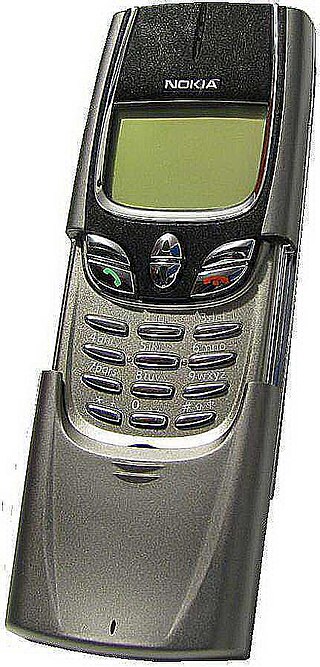
The Nokia 8850 is a mobile phone handset manufactured by Nokia. It was a light alloy-bodied enhanced version of Nokia 8210 model with slider protection of the keypad and white lighting of the keypad and screen. The 8850 is considered to be an un-repairable phone, thus resulting in very few active handsets in the market. Today it remains a collector's item. It also came in gold. It was introduced as a successor of an earlier model, the chrome phone Nokia 8810.

The Nokia 1110 and Nokia 1110i/1112 are low-end GSM mobile phones sold by Nokia. The 1110 was released in 2005; the 1110i/1112 was released in 2006. Both are aimed at first-time mobile phone users. In Nokia's view, the 1110i has the advantage of ease-of-use, reliability and a low price. These phones are very similar to the Nokia 1100. Between January and May 2007, the 1110 was sold by Nokia as their basic low-end monochrome model, before being superseded by the Nokia 1200. One of its key markets is that of developing countries.
The Nokia 6000 series or Classic Business series is range of mobile phones marketed by Nokia. This family of phones is notable for their conservative, unisex designs, making them popular with business users.
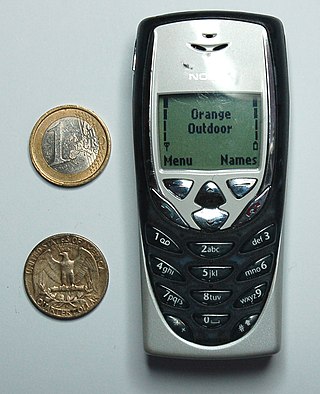
The Nokia 8310 is a mobile phone manufactured by Nokia between 2001 and 2002. Belonging to the 8000 series, the handset was a member of Nokia's flagship premium 'candybar' variety, and retailed for a price in excess of £400 on launch after its announcement at CEBIT in March 2001. Incorporating Nokia's trademark menu system and GUI with a white backlight colour, the device was easy to operate, yet contained advanced premium features not normally found on handsets of the time, such as infrared, a fully functional calendar, and was the first Nokia phone to support GPRS and an FM Radio.

The Nokia 2600 classic is a Nokia Dual-band GSM phone E900/1800 or E850/1900 that includes a VGA camera, FM radio, Bluetooth, E-mail and mobile Internet access via a WAP browser. Additionally, the Nokia 2600 supports MMS and Nokia Xpress Audio Messaging, for recording and editing messages on the go. It also had a similar sliding variant called Nokia 2680 slide.

The LG Cosmos is a slider mobile phone made by LG Electronics. The phone is available in both a touch screen and non-touch screen model. It became available on Verizon Wireless in Q1 2010, and was replaced by LG Cosmos 2 in July 2011. The phone has 1.3-megapixel camera, VZ Navigator, Voicemail, Media Center, QWERTY keyboard and SMS and MMS messaging.
The Nokia 8810 was a slider-style mobile phone handset manufactured by Nokia. The model was announced on March 18, 1998. It is notable for being among the first phones to have an internal antenna. It was designed to be the flagship and the most luxurious of all Nokia phones at the time, and was also one of the first phones with chrome plating.
The Nokia 1006 is a phone with a basic design for CDMA Technology. It was announced on 8 January 2009 and was released in the same month. This bar-style mobile has Bluetooth features, voice dialing and also has a GPS of A-GPS type.
